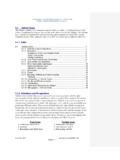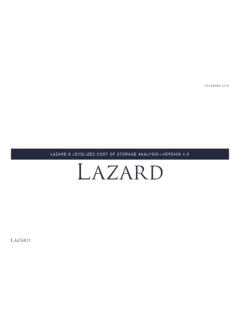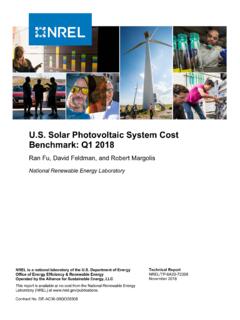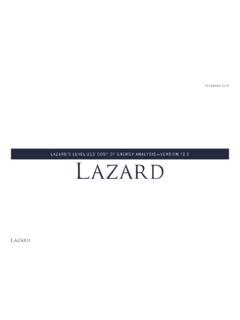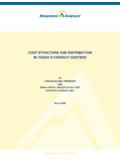Transcription of Overview RTD’s Mission is: To meet our constituents ...
1 Regional Transportation District Service Development Page 1 4/4/2018 Service Performance 2016 (Rev 4/2018) Networked Family of Services Overview RTD s Mission is: "To meet our constituents ' present and future public transit needs by offering safe, clean, reliable, courteous, accessible and cost -effective service throughout the district." Service development and performance analysis require that we ask several questions. What are the markets or demand? Should service be provided and how much? What type of service should be provided? RTD s general approach is as follows. Develop a family of services suited to a variety of markets. Connect all the services together in a network to accommodate today s dispersed travel patterns. Match the level-of-service with demand, thus improving performance and sustainability. Performance is a term often used interchangeably with effectiveness and efficiency.
2 The effectiveness-productivity charts in this report present these measures for all RTD services. Effectiveness measures attainment of the objective maximize ridership within the budget and is presented on the y-axis as subsidy per boarding. Efficiency productivity or output/input is presented on the x-axis as boardings/vehicle hour. The charts offer a convenient, comparative analysis of all classes of services, illustrating both absolute and relative performance. RTD service standards are depicted in the charts to help make judgments about performance. Each rectangle labeled by service type represents the domain for routes that meet or exceed the 10% minimum/maximum performance requirements for that service class. So this is a case where it s bad to be outside the box. Routes that perform minimally get minimum service frequency, typically every 30 minutes during peak periods and 60 minutes off-peak.
3 The charts also depict guidelines for routes where ridership significantly exceeds the minimum, and passenger loads justify more frequent service. The orange, dotted, vertical line at 25 boardings per hour represents the typical minimum productivity for a route to justify 15-minute frequency, and the green line at 40 boardings per hour for 10-minute frequency. Please note that these are true apples-to-apples comparisons of performance: all fare revenues, boardings and costs both operating and amortized capital are included. For complete, detailed information see RTD s Transit Service Policies & Standards (under Reports). NOTE For 2016 fare revenue was not allocated by route. Last year the fare zone structure was changed and Service Standards revised to combine the Express, SkyRide and Regional routes into one Regional class.
4 We also discovered some issues with the revenue allocation method in use for many years that will be addressed with a new model now under development to improve revenue allocation and provide better inputs into service performance evaluation. Due to all these changes, we did not have the resources to prepare accurate subsidy BetterSame boardings,less subsidySame subsidy,more boardingsSubsidy per Boarding or EffectivenessBoardings per Vehicle Houror ProductivityLowerHigherEffectiveness - Productivity Chart Regional Transportation District Service Development Page 2 4/4/2018 calculations for 2016, and the report reflects only cost or cost per boarding by route. The results are still very useful and similar to previous reports and we will provide a complete analysis for 2017. Definitions Boardings: Unlinked passenger trips; includes transfers as boardings.
5 Hours: In-service vehicle hours, not including dead head garage time or layover/recovery. Fare Revenues: Cash, ticket, and tokens allocated by route by farebox recorded boardings. Monthly pass revenues are allocated by class of pass and the number of uses by route. Revenue from Eco, CU, and Auraria passes are allocated individually by the counts for each route weighted by the ratio of the class of service fare to the local fare. Costs: All operating, maintenance and administrative costs for providing current service, plus depreciation on all RTD assets. Excludes interest and any costs attributed to future projects. RTD s cost allocation model allocates costs to each route based on its miles, hours, and peak vehicles; accounting line items are assigned to the most relevant variable. Subsidy: Costs minus Fare Revenues.
6 Standards RTD has established guidelines in its Transit Service Policies & Standards that the least productive 10% of routes based on either subsidy per boarding or boardings per hour need to be evaluated for marketing, revision or elimination, or if both measures fall below 25% for a route. The performance charts illustrate the acceptable performance domain containing all routes meeting the 10% minimum/maximum for each class of service. The calculation of the 10% and 25% standards are made from the annual, un-weighted data, assuming the data have a normal distribution and using the appropriate formulas for standard deviation and confidence intervals; however, the standard deviation is applied to the weighted average. The following table gives the current year weighted averages and standards by class of service. Year 2016 Service StandardsService ClassAverage10% Max25% MaxAverage10% Min25% MinCBD Local$ $ $ Local$ $ $ Local$ $ $ $ $ $ $ $ $ $ $ $ $ $ $ $ 2015*$ * Subsidy per BoardingCost Per BoardingBoardings Per Hour Regional Transportation District Service Development Page 3 4/4/2018 Notes on Routes Outside Their Acceptable Performance Domain The following provides the status of these routes as of October, 2017 listed in route number order.
7 Route 9 West 10th Ave Restructured April 2013 with the West Corridor opening. Current ridership productivity slipped below standard this year and this route will be monitored for further action. Route 32 32nd Ave/City Park Current ridership and subsidy are below standards. Duplication with the Route 40 on Colorado Blvd was eliminated in April 2016. Route 33 Platte Valley This service was restructured from the Route 34 in August 2015 in hopes of gaining ridership with a new routing. We will continue to monitor for further action and possible discontinuance. Route 36L Fort Logan Ltd The Route 36L was linked to and classified with Routes 29 and 36 in the Urban Local category. The service will be monitored, though a Federal Boulevard service restructure is planned that would impact the Route 36 if implemented. Route 48 East 48th Ave/Commerce City This service currently meets the ridership standard and narrowly misses the cost per boarding standard, it will be monitored for further action.
8 It is likely that the route will be impacted in the N Line bus and rail service plan. Route 72L Quaker St via Ward Ltd The route currently meets the ridership standard, though it is outside of the cost per boarding standard. The route will be replaced in the implementation of the G Line bus and rail service plan. Route 85 Chatfield Avenue Formerly a part of the Route 401, the Route 85 was created in August 2015 to provide clarity as to where buses are traveling and allow better monitoring of the route. Route 89 Stapleton/Anschutz Campus This route was started January 2013 to serve new transitional housing and in anticipation of the opening of the East Corridor rail services in 2016. In 2014 service was reduced by half due to poor performance and ridership fell precipitously. This service has been proposed for discontinuance in January 2018.
9 Route 100L South Kipling Ltd This service meets the ridership standard, but falls short of the cost per rider standard. We will continue to monitor its performance for further action. Route 116L Ken Caryl Limited This route was discontinued January 2017. Route 157 CCA/Buckley This route was newly implemented in April 2016, formed from former segments of Routes 10, 130 and 169. Current ridership does show improvement this year (13 passengers/hour) and will be monitored closely. Route 403 Lucent Blvd Service realigned and retimed for January 2014 and performance improved somewhat. It is now below subsidy and productivity standards and will be monitored. Route 410 Franktown/Parker This route was substantially revised with the reinstatement of Route P Parker/Denver Spring 2007. Service was reduced to every 30 minutes peak and every two hours midday.
10 Service was reduced to peak period only May 2009. Additional trips added January 2014 in response to public meetings where constituents noted that this would make the route more attractive. In 2016 this route was combined with a portion of the Route 153 to form the new Route 483 Lincoln/Parker/Nine Mile. Route 483 This service was implemented in April 2016 with the University of Colorado A Line bus and rail service plan. The route is a combination of a segment formerly on the Route 153 in Southeast Arapahoe and the Route 410 in Parker. Regional Transportation District Service Development Page 4 4/4/2018 Route AA Wagon Road/DIA Performance is just below service standards. Considering potential restructuring with the North Metro Corridor service plan. Route CV Pine Junction/Conifer/Denver This route is slightly below subsidy standard, but above productivity standard.
